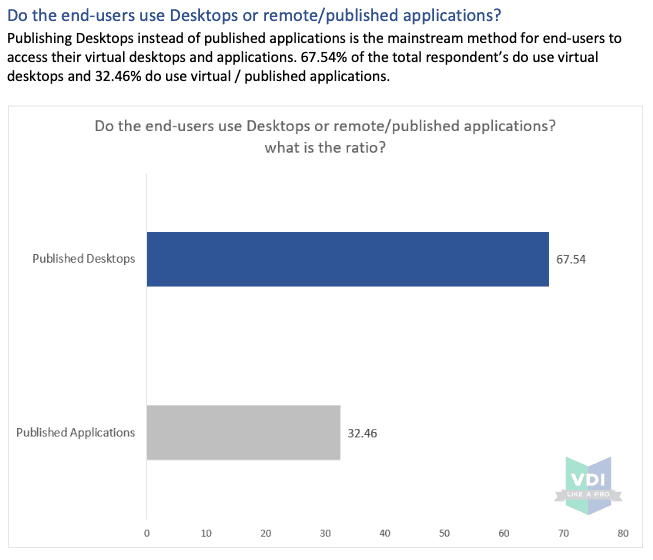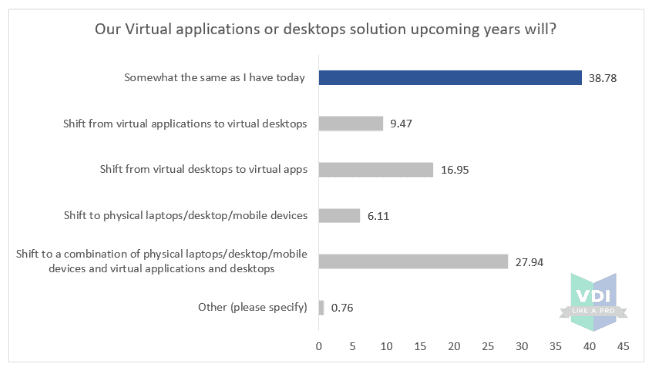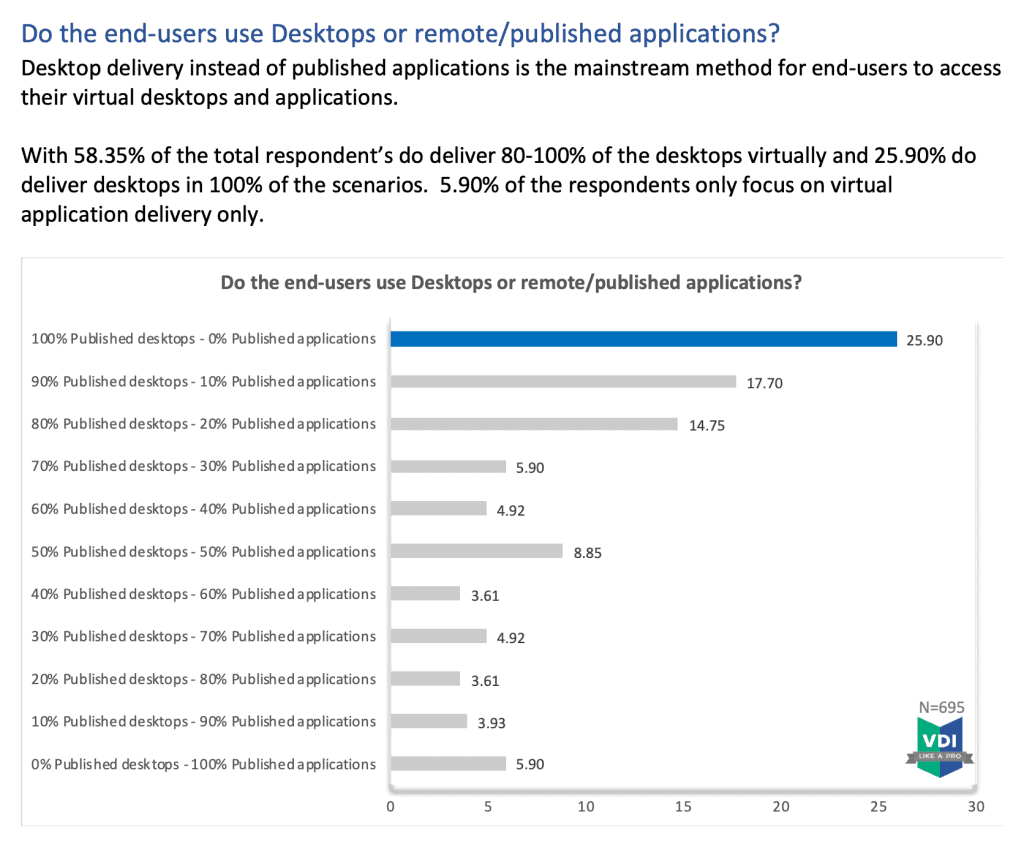If you’ve heard people proclaim that this is the “Year of Virtual Desktops/VDI”, you’re certainly not alone. It’s a claim that people have been making for a decade now, but which has gained significantly more steam this past year. And while data supports that adoption of Virtual Desktops has grown, data from the recently-released “VDI Like a Pro” report illustrates a really interesting counter-trend:
Virtual Application Delivery has not just established itself as a strong alternative to Virtual Desktops – data also shows we’re currently in the middle of a shift from Virtual Desktops to Virtual App Delivery.
First, let’s start with the current breakdown of usage between Virtual Desktops and Virtual apps. Here’s what the 2021 “VDI Like a Pro” report (the EUC industry’s largest annual independent survey) shows:

As you can see, Virtual Desktops are currently still the predominant technology utilized today – but things get really interesting when you look at a later question in the 2021 report that asks about these organizations’ future plans:

The survey data shows that 16.95% of the organizations that are currently utilizing Virtual Desktops solutions plan to shift from Virtual Desktops to Virtual Apps. When you add that 16.95% to the 32.46% of organizations who’ve already chosen Virtual Apps over Virtual Desktops, that would bring the percentages to 50.6% for Virtual Desktops and 49.4% for Virtual Application Delivery. A nearly 50/50 split.
And for additional context, let’s take a look at the 2020 data. In the 2020 report, only 5.9% of organizations were focused solely on Virtual Application Delivery:

Granted, in 2021 the report did not include the chart above, and seemed to simplify the question to identify simply whether the org’s end users relied on Virtual Desktops or Virtual Apps. One way to look at it is that in 2020 only 5.9% of orgs said that 100% of their users relied on Virtual Apps, whereas 32.46% of orgs said their people rely on Virtual Apps in 2021. That’s a nearly 6x increase in just one year.
Even if you add up all of the responses from 2020 that said a “majority” of users relied on Virtual Apps vs. Virtual Desktops, that number was 21.07% in 2020 compared to 32.46% in 2021.
Regardless, the fact that nearly 17% of today’s Virtual Desktop users plan to shift to Virtual App Delivery, bringing Virtual Desktops & Virtual Apps to parity at a 50/50 split of the market, is astounding. Just 1-2 years ago, Virtual App Delivery wasn’t even its own category – it was rolled into Virtual Desktops, which has been the touted technology for 2 decades. To see such a rapid market shift from 2 decades of Virtual Desktop traction to Virtual Apps becoming the focus for 50% of the market in just 2 years begs the question – why are we now seeing such rapid adoption of Virtual App Delivery?
The simple reality is that Virtual Desktops are and always have been focused on a very specific subset of the market – the 15-20% of power users who have specific workload needs that require a full Virtual Desktop. But for 80% of the market, Virtual Desktops are overkill from both a cost and complexity perspective. That 80% of the market primarily needs secure access to all of the critical apps that they need to productively do their job on any device. Here’s what one of our reseller partners had to say about why they recommended Cameyo’s Virtual App Delivery platform over VDI or DaaS for a recent customer:
“Too often there’s a misconception that VDI or DaaS are the only options when it comes to enabling remote and hybrid work,” said Fredrik Linnander, CEO of Online Partner. “The reality is that most companies simply need a secure, cost-effective way to deliver a handful of business-critical Window and web applications to any device, from the browser. Cameyo is the simplest, most secure, and most cost-effective Virtual App Delivery solution we’ve experienced, and we knew this would be a perfect fit for Klarahill.”
And with Virtual App Delivery that can be done much more securely, far more affordably, and with considerably less complexity than VDI & DaaS (with Virtual App Delivery able to be deployed in hours, not weeks or months). But don’t take our word for it. These are all common themes across almost every case study we’ve published to date. Here are some examples from our recent case study with Klarahill, a customer who recently shifted away from utilizing Virtual Desktop products to using Cameyo’s Virtual App Delivery:
Simplicity
“To be honest, Cameyo was so simple to set up that I was skeptical at first. After just three hours, when we had it completely set up and our critical apps published, that skepticism quickly turned into a sense of awe,” said said Adam Nerell, Head of IT for Klarahill.
Security
“With Cameyo you get this very powerful solution, with very low complexity and cost, all while getting greater security than you’ll find in other solutions. Complexity is the antithesis of security. The more complexity a solution has, like the many components of virtual desktop solutions, the more potential security issues you will have. Cameyo is built on a zero trust security model, and it also strips away all of the complexity that could result in security issues down the line,” said Nerell.
Cost-Effectiveness
“Just looking at month-to-month cost compared to our previous remote desktop solution, with Cameyo we are paying only 15% of what we used to pay. But then on top of that 85% savings, we also no longer need windows clients, so we save even more money there. In addition, we have far fewer support issues, so we save even more,” said Nerell.
Deploying in hours instead of months. Saving 85% over Virtual Desktop products. And benefitting from far greater security in the process. These are just some of the reasons that the organizations are making the shift from Virtual Desktops to Virtual App Delivery. If you’re interested in learning more about the benefits companies are seeing from Virtual App Delivery, check out all of our case studies here, or book a demo if you’d like us to walk you through some live examples. Prefer to kick the tires yourself? Go ahead and start your free trial of Cameyo now and you can have your first application published in less than 10 minutes.
